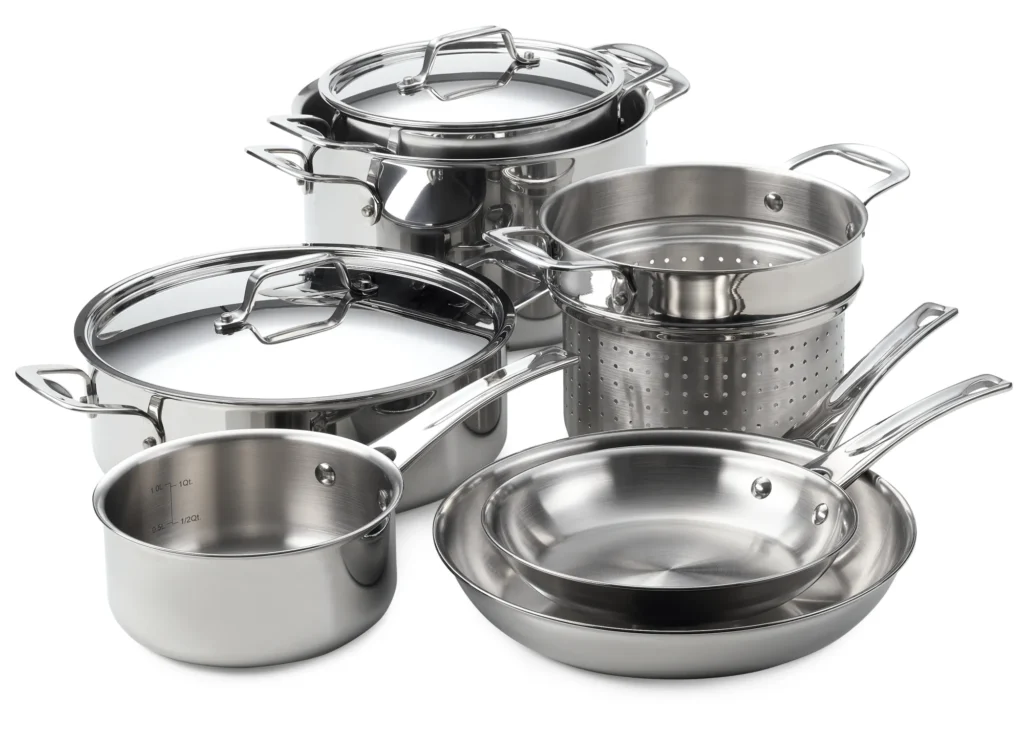
“How do you manufacture cookware?” involves several processes, including designing, material selection, forming, cutting, welding, polishing, and packaging. Here is a general overview of the manufacturing process:
- Design: Cookware manufacturers first design the product, which includes deciding on the size, shape, and features of the cookware.
- Material Selection: The manufacturer selects the appropriate material for the cookware based on its intended use. Common materials include stainless steel, aluminum, copper, and cast iron.
- Forming: The selected material is then formed into the shape of the cookware using a variety of methods such as stamping, spinning, or deep drawing.
- Cutting: The formed material is then cut to the required size and shape using machines such as laser cutters, water jets, or shears.
- Welding: The individual pieces of the cookware are welded together using various techniques such as spot welding, seam welding, or TIG welding.
- Polishing: The cookware is polished to remove any rough edges and to achieve a smooth, shiny finish. This can be done using a variety of machines such as rotary polishing machines, vibratory polishing machines, or buffing machines.
- Packaging: The finished cookware is packaged and labeled for shipping.
Overall, cookware manufacturing requires specialized machinery and skilled workers to produce high-quality products that are safe, durable, and aesthetically pleasing.
In our kitchens, there are numerous items and tools that we use in our daily life. The kitchen is one of the most important places in a house as nourishment is one of the main reasons why we live. Humankind has developed and been developing so many different cookware objects to feed itself and to develop new answers to the question “How do you manufacture cookware?”
In this section, you will find information about the manufacturing processes of metal pots, which are one of the main objects in a kitchen.
Metal pots generally can be of 3 main kinds:
- Stainless steel pots
- Cast iron and aluminum pots
- Nonstick coated pots
How Do You Manufacture Cookware?

The manufacturing process of cookware involves a series of carefully orchestrated steps that transform raw materials into high-quality, durable, and aesthetically pleasing cooking utensils. It encompasses several stages, each contributing to the overall quality and functionality of the finished product.
Stage 1: Raw Material Preparation
The journey begins with the procurement of high-grade raw materials, including stainless steel sheets, aluminum ingots, and various components such as handles, lids, and gaskets. These materials undergo rigorous inspections to ensure they meet the specified standards for purity, composition, and strength.
Stage 2: Forming and Shaping
The raw materials are then transformed into the basic shapes of the cookware pieces. This stage involves various forming techniques, such as:
- Stamping: Stamping utilizes a press to stamp the sheet metal into the desired shape, such as the body of a pot or pan.
- Roll Forming: Roll forming continuously rolls the sheet metal through a series of rollers, gradually shaping it into the desired form, such as a cylindrical canister or a rectangular baking sheet.
- Deep Drawing: Deep drawing stretches a flat sheet of metal into a cup-like shape, such as the bowl of a pot or pan.
Stage 3: Welding and Fabrication
The formed components are then joined together using precision welding techniques, such as TIG (Tungsten Inert Gas) welding or MIG (Metal Inert Gas) welding. These techniques create strong, leak-proof welds that ensure the integrity of the cookware. Additionally, handles, lids, and gaskets are attached using appropriate welding or mechanical fasteners.
Stage 4: Polishing and Finishing
To achieve a smooth, shiny, and hygienic surface, the cookware undergoes a meticulous polishing and finishing process. This may involve vibratory tumbling, centrifugal polishing, or manual polishing using abrasive materials. The polishing removes imperfections, enhances the appearance, and prepares the cookware for subsequent steps.
Stage 5: Cleaning and Sanitization
To ensure the safety and quality of the cookware, thorough cleaning and sanitization are essential. This involves washing the cookware with detergents, rinsing with hot water, and subjecting it to disinfection processes using appropriate chemicals. These steps eliminate any potential contaminants that could affect the safety of food prepared in the cookware.
Stage 6: Quality Control and Testing
Prior to packaging and shipping, the cookware undergoes rigorous quality control measures to verify its integrity and performance. This may include leak testing, pressure testing, dimension checks, and visual inspection to ensure that the cookware meets the highest standards of quality and functionality.
Stage 7: Packaging and Shipping
The inspected and approved cookware is then carefully packaged using appropriate materials and methods to protect it from damage during transportation. The packaging ensures that the cookware arrives at its destination in pristine condition, ready for immediate use.
Technological Advancements in Cookware Manufacturing
The cookware industry is constantly evolving, embracing new technologies and innovations to enhance the manufacturing process, improve product quality, and expand design possibilities. Some notable advancements include:
- Laser Cutting: Laser cutting machines offer precise and intricate cutting capabilities, enabling the production of complex shapes and designs in cookware.
- Automated Welding Systems: Automated welding systems ensure consistent, high-quality welds, reducing human error and improving production efficiency.
- Electroplating Techniques: Electroplating techniques add decorative and protective coatings to cookware, enhancing its appearance and durability.
- Non-Stick Coatings: Non-stick coatings are applied to cookware surfaces to prevent food from sticking and facilitate easy cleaning.
- Ergonomic Handles: Ergonomic handles are designed to provide comfort and grip during cooking, enhancing the user experience.
Conclusion
The manufacturing of cookware encompasses a series of interconnected steps, each contributing to the creation of high-quality, durable, and aesthetically pleasing cooking utensils. By employing advanced technologies, implementing rigorous quality control measures, and embracing innovation, cookware manufacturers are ensuring that their products meet the
How do you manufacture cookware?
Stainless steel pots are the most common cookware products in our daily lives as they never get rusted, aged, or damaged. They are durable, healthy and economic in comparison with the other pot types
Stainless steel pots are manufactured by the technology called “deep drawing”. For this, you need to manufacture circle blanks from stainless steel. This operation is manufactured either by a mechanical eccentric press that cuts circles from sheet metal or you can use a circle cutting machine to cut the corners of square sheet metal to turn it into a circle. The first way is much faster but the second way is much cheaper. The diameter of the blanks determines the diameter and the depth of the pots. The bigger the diameter of the metal circle sheets, the bigger the pots will be.
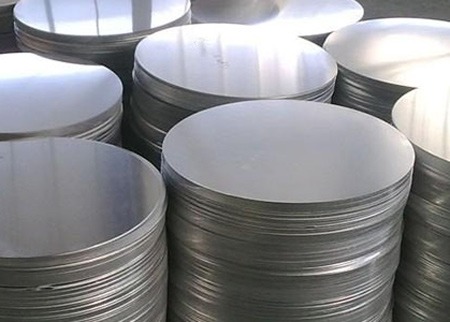
How is cookware manufactured?
After the circle sheets are prepared, the process continues with the second step: Drawing or Deep drawing. Drawing is a technological process, where the metal circle sheet transforms into another object with a die pair. The same operation is called “Deep drawing” when the depth of the new object exceeds its diameter.
For drawing or deep drawing, you need a hydraulic press, powerful enough to draw the metal sheet circle into a pot. The operator puts the metal circle sheets between the dies and starts the process. The upper plate also called “the pressing plate” starts to come down and meanwhile the downside plate also called the cushion cylinder starts to go up. the male die starts to shape the sheet metal circle into a pot. If the depth of the pot is not bigger than the diameter then, this operation is called “drawing”, otherwise it is called “deep drawing”
The Hydraulic press for drawing or deep drawing can be of various powers starting from as small as 40 Tonnes up to 4000 Tonnes for big parts such as reservoir tank caps.

How do you manufacture cookware?
Before this process, the operator needs to use a lubricator on the sheet metal circles to reduce the friction between the sheet metal and the die sets. The insufficient use of lubricator between the surfaces that face friction may lead to production failures such as tears or cracks.
The process of drawing may take up to 1 min depending on the circle diameter and product geometry complexities. After each cycle, the operator needs to take the part out and put a new metal sheet circle in between the dies for a new cycle.
Drawing presses have accelerated the production of cookware in many folds as before the hydraulic drawing presses most of the cookware was being manufactured in some very inefficient ways including eccentric presses (this led to so many product failures as the speed of the process is not controllable)
After the cycle ends, the operator collects all the deep-drawn parts and prepares them for the next step: Degreasing
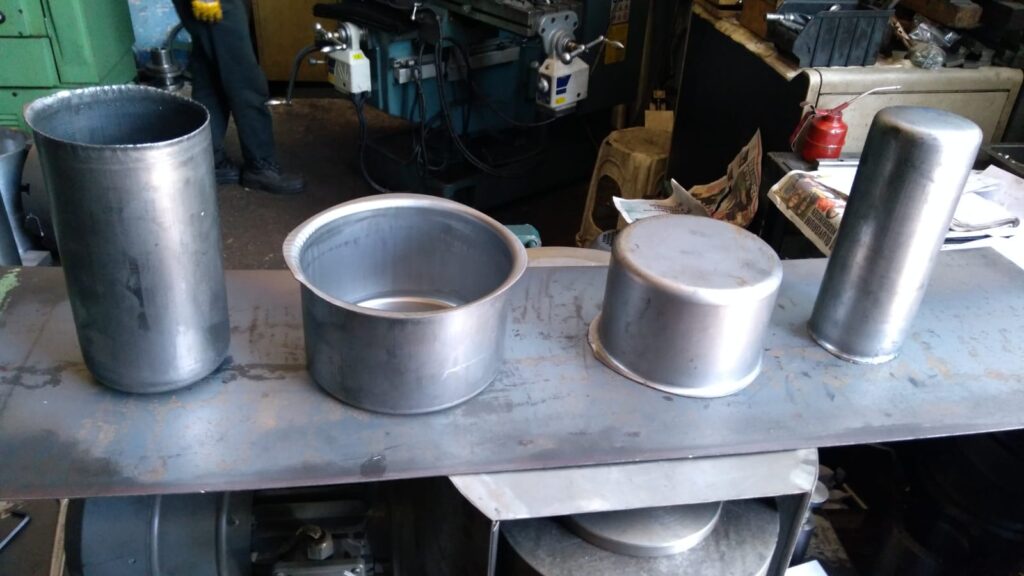
The step after drawing or press forming is actually “edge cutting and trimming” but as the parts are greased before the drawing operation, this left grease on the parts causes problems during the edge cutting operation. In an edge cutting operation, the part is fixed on a mold and a pneumatic cylinder presses the part from above to avoid any movement out of the cylinder axis. After that, the part starts to rotate with the help of an electric motor in the edge cutting trimming machine.
During that rotation, if there is still grease on the part, the upper pneumatic cylinder may not keep the part in its place and even if the mold in the part rotates, the part may stay still and this avoids any cutting or trimming operation. So, as EMS Metalworking Machinery, we advise degreasing the parts before they go on to the edge cutting operation.
Edge cutting trimming beading curling
The parts that are manufactured with a deep drawing press, have some rims on them, which need to be removed. These edges are usually sharp, uneven, and dangerous by handling. For this operation, we design edge cutting machines for round sheet metals or “edge cutting and trimming machines” as known in the industry.
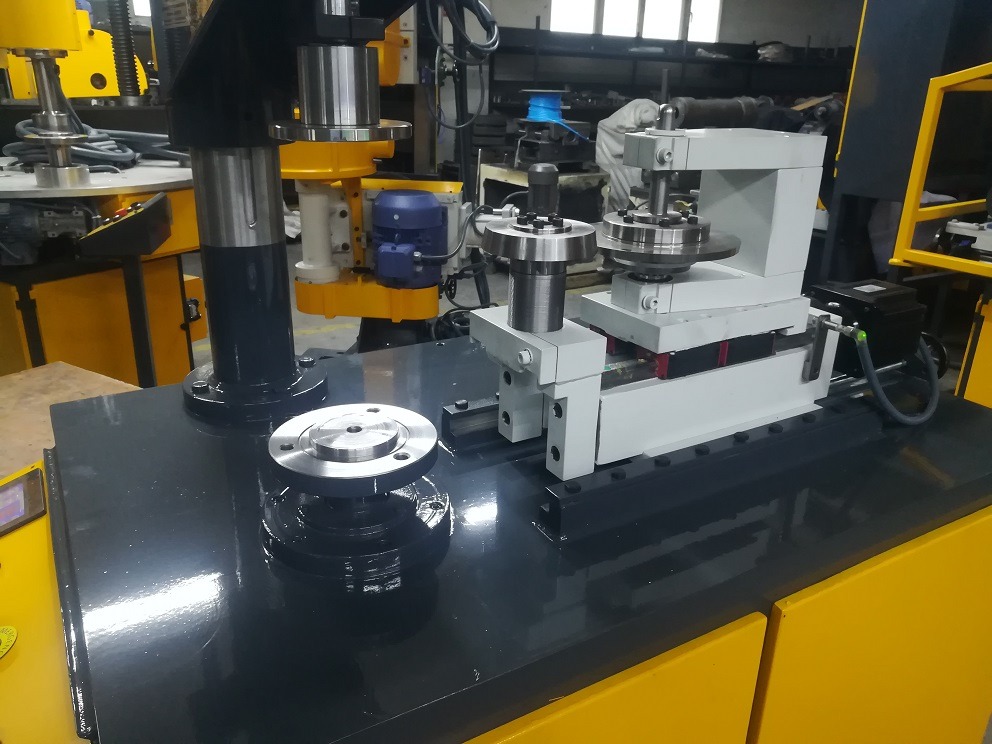
The stainless steel or aluminum pots are put on the male mold of the edge cutting machine. The upper mold, fixed on the tip of the pneumatic cylinder moves down to fix the part and the part starts to rotate with the help of the AC electric motor in the machine. After the starting of the rotation, the cutting tool (shown on the right side of the photo) starts to move to the rotating part and the cutting tool gets into contact with the part exactly at the point, below which needs to be removed.
The cutting tool cuts the part in less than half a second and the cut circle falls down apart from the part itself. This operation is called “edge cutting”. After this edge cutting, companies may require to have cookware products with more clean and even edges. For this purpose, the same edge-cutting process may proceed to edge trimming with the upper side of the cutting tool.
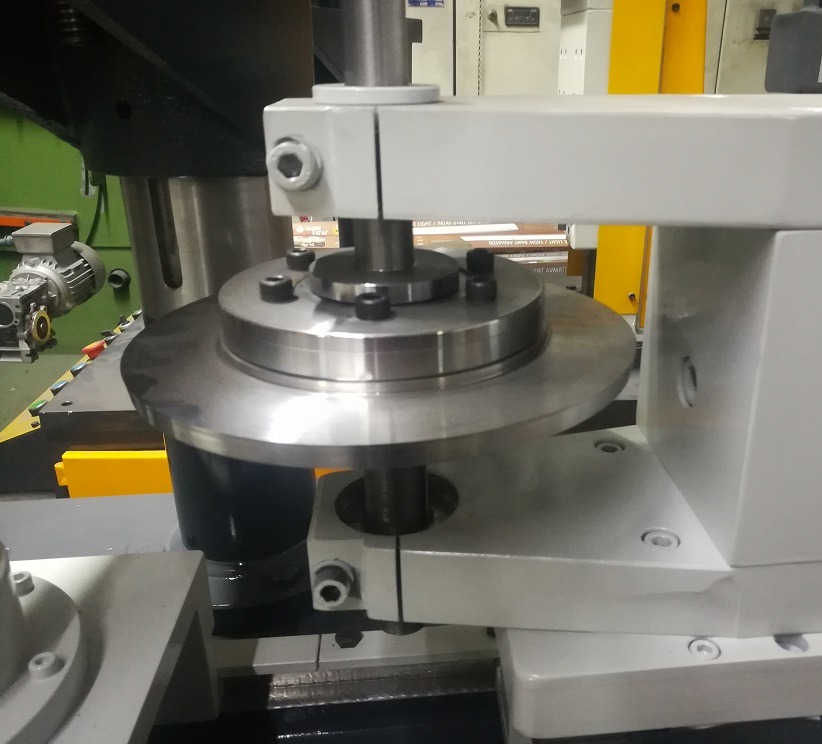
This process, either “edge cutting” or “edge trimming” or any other special metalworking processes like “beading or curling” takes a maximum of 4-5 seconds. So from this point, an edge cutting trimming machine may work with 5-6 presses together and 1 machine can cut the edges of the round sheet metal parts that are being manufactured by 5-6 presses at the same time.
Below from the video, you can see the speed of an edge cutting machine that does cutting and then beading inside in less than 5 seconds per cycle
Edge cutting machine is the last metalworking operation on the cookware production line, that changes the shape of the part. After this point, the pot has its final shape and is ready to continue with polishing or wiping.
Polishing machine for inside and outside surfaces
Most of the stainless steel and aluminum cookware we use have fine finishing and this fine satin finishing is done by polishing machines
Polishing machines are metalworking machinery that does not change the shape of the parts. They polish the inside or outside surfaces of the pots, pans, kettles, or other stuff by using some polishing abrasives and materials.
This operation can be organized in such a way that a single pot may go through 3-4 or even higher steps of polishing. The number of steps is determined by the finishing quality.
Our polishing machines can be with 1 or 2 polishing heads for easier finishing requirements but can also be equipped on a rotating table when there need to be more than 3 polishing stations. Polishing stations can be equipped with polishing compounds that can remove the deep marks, scratches, and heavy marks. You can polish cooking utensils, cutlery, kitchen sink, pots, pans, and even automobile parts.
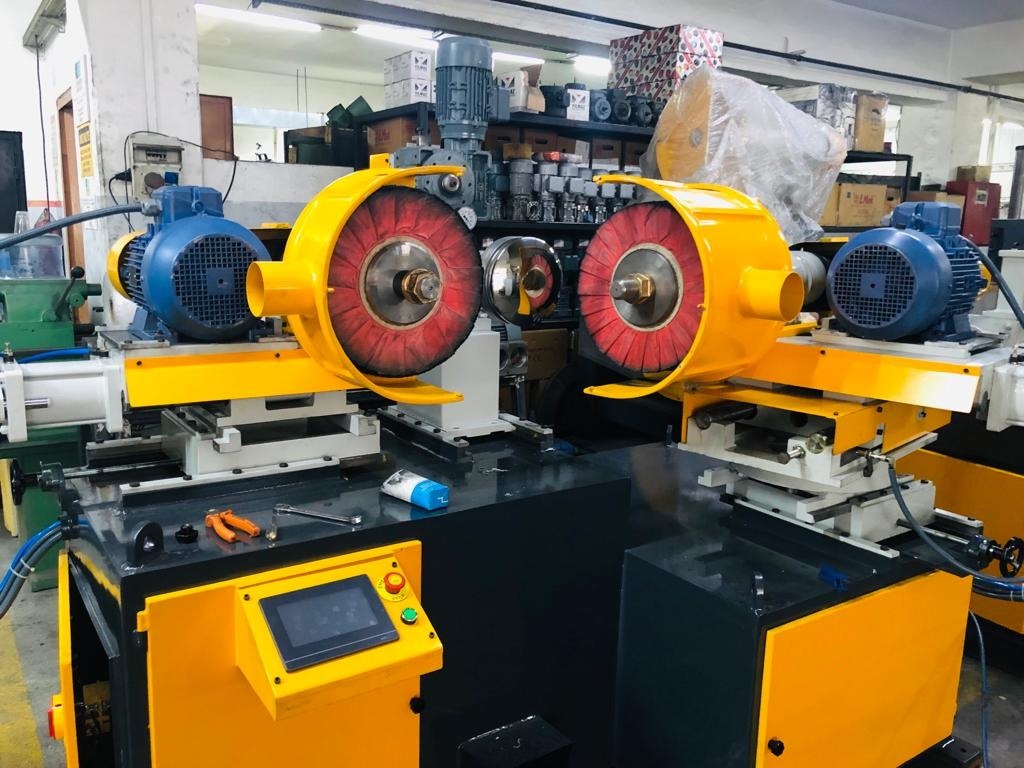
Piercing and riveting the handles to cookware
After we polish the cookware with the necessary compounds, the next operation is piercing the edges of the pot and riveting handles to those pierced holes. The rims of the stainless steel pots are pierced on a punching machine where 1 or 2 holes are pierced at the edge of the pot. The holes are used to rivet the handle to the pot later.
Riveting is a fixing operation, applied on sheet metals. A rivet is a fixing nail with 2 parts: 1) Rivet body and 2) Mandrel. Rivet’s body goes into the pierced hole and is deformed so that it cannot move back again
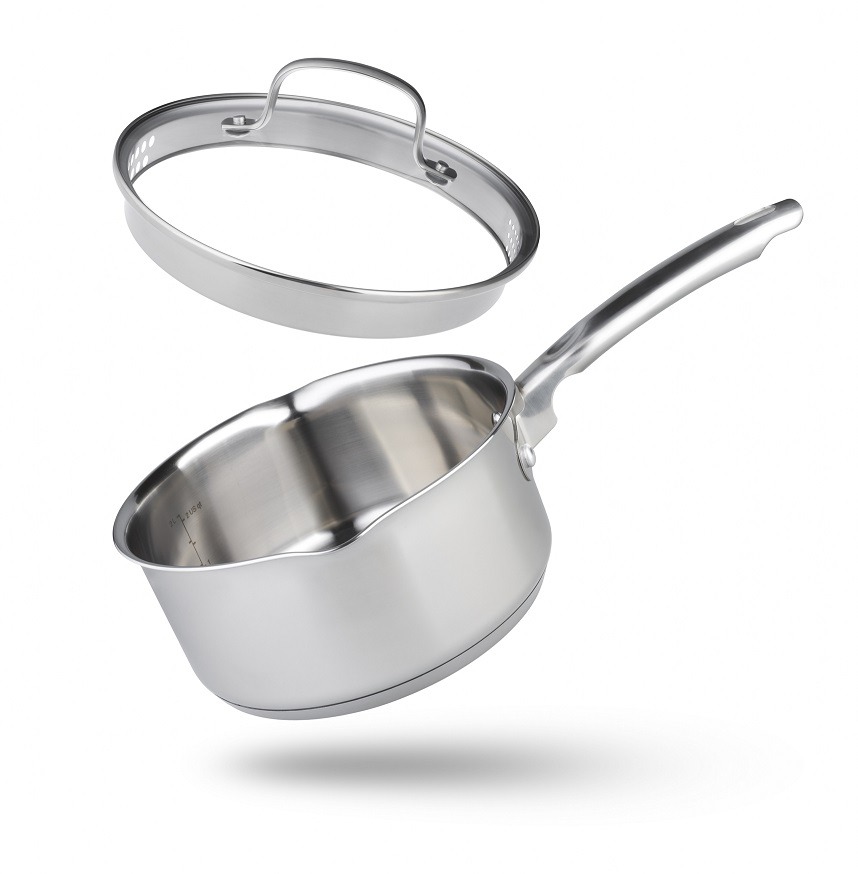
After the riveting operation, you can have the products go through some washing with chemicals to clean them from the oil and dirt. When the parts are cleaned, they can proceed to packaging and to the market shelves for the customers
EMS Metalworking Machinery
We design, manufacture and assembly metalworking machinery such as:
- Hydraulic transfer press
- Glass mosaic press
- Hydraulic deep drawing press
- Casting press
- Hydraulic cold forming press
- Hydroforming press
- Composite press
- Silicone rubber moulding press
- Brake pad press
- Melamine press
- SMC & BMC Press
- Labrotaroy press
- Edge cutting trimming machine
- Edge curling machine
- Trimming beading machine
- Trimming joggling machine
- Cookware production line
- Pipe bending machine
- Profile bending machine
- Bandsaw for metal
- Cylindrical welding machine
- Horizontal pres and cookware
- Kitchenware, hotelware
- Bakeware and cuttlery production machinery
as a complete line as well as an individual machine such as:
- Edge cutting trimming beading machines
- Polishing and grinding machines for pot and pans
- Hydraulic drawing presses
- Circle blanking machines
- Riveting machine
- Hole punching machines
- Press feeding machine
You can check our machinery at work at: EMS Metalworking Machinery – YouTube
Applications:
- Beading and ribbing
- Flanging
- Trimming
- Curling
- Lock-seaming
- Ribbing
- Flange-punching
